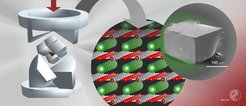Topotactic transformation of single crystals: From perovskite to infinite-layer nickelates
First synthesis of bulk infinite-layer nickelates
Synthetic routes to materials in which anions are partially removed, inserted, or exchanged are rapidly gaining attention in solid-state physics and chemistry. In particular, soft chemistry topotactic reductions of perovskite-related transition metal oxides have opened up possibilities to prepare new families of functional electronic and magnetic materials. Recently, a breakthrough in the field of unconventional superconductors was achieved with the discovery of superconductivity in thin films of Sr and Ca substituted infinite-layer nickelates RENiO2 (RE = La, Pr, and Nd), obtained via topotactic oxygen deintercalation of the perovskite phase RENiO3. Yet, superconductivity in infinite-layer nickelates has been observed exclusively in thin film samples, whereas polycrystalline powders with similar compositions show insulating behavior at all temperatures. In the present study, we have synthesized perovskite La1−xCaxNiO3 single crystals, which were reduced to the La1−xCaxNiO2 infinite-layer phase, using CaH2 as a reducing agent. Remarkably, we find that the reduced crystals exhibit a metal-like electrical conductivity that is reminiscent of weakly hole-doped infinite-layer thin films, which is in stark contrast to previous results on powder samples.

A major challenge concerning the preparation of infinite-layer nickelate crystals, besides the highly invasive topotactic reduction, is the synthesis of the precursor perovskite phase RENiO3, which requires extreme oxidizing conditions to stabilize the Ni3+ valence state. Here, we realized such conditions via a salt-flux growth with a perchlorate oxidizer in a 1000–metric ton press equipped with a Walker module, provided by the Quantum Materials Department at MPI-FKF. The subsequent reduction was carried out using CaH2 as a reducing agent in spatial separation to the nickelate crystals. The transformation from the three-dimensional perovskite to the quasi–two-dimensional infinite-layer phase was thoroughly characterized by x-ray diffraction, electron microscopy, Raman spectroscopy, magnetometry, and electrical transport measurements. In particular, a scanning transmission electron microscopy (STEM) investigation of the Stuttgart Center for Electron Microscopy (StEM) at MPI-FKF revealed the excellent crystalline quality of the obtained crystals, with homogeneous Ca distribution and no detectable defects on length scales exceeding the thickness of previously reported films by orders of magnitude. Furthermore, complementary electron energy-loss spectroscopy (EELS) measurements demonstrated close similarities between the electronic structures of our infinite-layer crystals and thin films of similar compositions.
In a broader context, our work signifies that topotactic reductions can be applied to bulk single-crystalline specimen, providing new perspectives for the transformation of three-dimensional to quasi–two-dimensional materials. Specifically, we anticipate that topotactic reductions are feasible for a wide variety of perovskite oxides with distinct morphologies. While perovskite oxides are already widely used as functional materials for energy storage and conversion, catalysis, and ionic conduction, they might show superior performances and/or new functionalities after topotactic transformation. Finally, the observed metal-like electrical conductivity suggests that infinite-layer nickelate crystals with higher Ca-substitution levels than in the present study are a promising candidate for hosting superconductivity.











